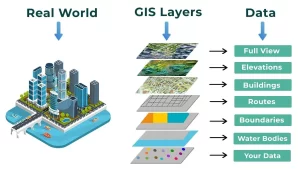GIS Data (Geographic Information Systems) uses, advantages and disadvantages
A geographic information system is commonly referred to as a GIS, It is an integrated set of hardware and software tools used to manipulate and manage the digital spatial (geographic) and related attribute data.
What is A GIS?
A (GIS) is a computer-based tool for mapping, and analyzing geographic phenomenon that exists and the events that occur on Earth, It integrates common database operations such as the query and the statistical analysis with the unique visualization and geographic analysis benefits offered by maps.
GIS Technology can capture all kinds of geographical reference data as well as digitally manipulate images from the Earth’s surface and it presents the data in a 3-D, The professionals and domain specialists are using GIS technology for addressing their unique spatial problems.
GIS Technology has superb abilities that distinguish GIS from other information systems and make it valuable to a wide range of public and private enterprises for explaining events, predicting outcomes, and planning strategies.
Map making and geographic analysis are not new, but a GIS performs these tasks faster and with more sophistication than traditional manual methods.
Geographic Information System is a multi-billion-dollar industry employing hundreds of thousands of people worldwide, It is taught in schools, colleges, and universities throughout the world.
GIS technology provides the facilities for data capture, data management, data manipulation, and analysis, and results presentation in both the graphic and report form, with a particular emphasis on preserving and utilizing inherent characteristics of spatial data.
GIS is used in conservation research, It offers better time management as finding the locations is almost instant, The collection of data is quicker with GIS and the location is more accurate if the signal can be found.
Many data can be displayed and inventoried with the use of GIS such as natural resources, wildlife, cultural resources, wells, springs, water lines, fire hydrants, roads, streams, and houses.
GIS data and associated model output are as good as the remote sensing methods from which they are derived such as aerial photographs, satellite imagery, laser altimetry, field surveys, digitizing, etc.
Advantages of GIS technology
Geographic Information Systems can visualize spatial information, It has the power to create maps with the images shown, It can be used for a vast range of tasks involving geography, It can provide solutions for problems, and can model seismic activity precisely.
GIS technology offers time management, It offers a quick collection of data, It presents a catalog of data, It has high accuracy, It presents better predictions and analysis.
GIS improves organizational integration, It can integrate hardware, software, and data for capturing, managing, and analyzing and it can display all forms of geographically referenced information.
It allows us to view, understand, question, interpret, and visualize the data in many ways that reveal relationships, patterns, and trends in the form of maps, globes, reports, and charts.
A GIS helps you answer questions and solve problems by looking at your data in a way that is quickly understood and easily shared, GIS technology can be integrated into any enterprise information system framework.
GIS data is used in natural resource management that can include hillslope gradients, aspects, stream networks, stream gradients, vegetation, and other watershed features and there is another type of GIS information which is vector (line) data such as the stream channels.
Geographic Information Systems (GIS) offer a powerful set of tools for working with location-based data. GIS is used in various fields, including environmental science, public health research, marketing, logistics, precision agriculture, historical preservation, and archaeology.
GIS excels at analyzing data based on its location. You can identify patterns, trends, and relationships between different datasets that wouldn’t be evident otherwise. GIS automates many tasks, saving time and effort. It also allows for better organization and management of large datasets.
GIS can create maps and other visual representations that make complex data easy to understand. This is helpful for communication and decision-making. GIS helps optimize resource allocation by analyzing factors like land use and infrastructure. This can be applied to tasks like waste collection or emergency response.
GIS automates tasks like data analysis and map creation, saving time and effort compared to manual methods. GIS can combine data from different sources, even if they have different formats, allowing for a more comprehensive picture.
GIS excels at combining data from various sources like maps, photos, and statistics. This allows for a comprehensive view of a specific location. GIS can analyze patterns and relationships across geographical locations. This is useful for tasks like identifying disease outbreaks or predicting crime hotspots.
By providing clear visuals, different datasets, and insightful analysis, GIS helps make informed decisions in various fields such as urban planning, resource management, disaster response, and environmental protection.
Disadvantages of GIS technology
Geographic Information System is very expensive software, Implementing and maintaining a GIS system can be expensive, including software licenses, staff training, hardware upgrades, and data acquisition. It requires an enormous amount of data inputs to be practical for some tasks, It makes it prone to error, It has relative loss of resolution and it has a violation of privacy.
Geographic Information System signal needs to be found in remote areas, It is too heavily relied on, and the geographic error is increased as you get to a larger scale as the earth is round, Funding for GIS is needed because it is more costly, there will be a loss of knowledge of geography.
GIS layers cause some costly mistakes when property agents are to interpret the GIS map or the design of the engineer around the utility lines of the GIS, The data availability is a major issue, If the data is not available, then the GIS system is useless.
Disadvantages of using GIS are that its technical nature may portray results as being more reliable than they are and the errors and the assumptions can be hidden, leading to a lack of questioning into the results.
Another issue with analyzing the results from a GIS is that the results will only be as accurate as the data that they come from, So, the data may not be able to serve different contexts, particularly if the data is not applicable.
GIS technology is not like other programs, It does not come off the shelf, so it must be assembled and constructed to the user’s design, This could be a long, complex, and costly process, So, Some GIS systems can fail in their implementation as their creation was rushed or inadequately planned.
GIS systems are so complex, that the technology behind GIS technology expands rapidly, causing GIS systems to have a high rate of obsolescence, As GIS is relatively new, integrating GIS data with traditional maps is difficult.
It’s very hard to make GIS programs that are both fast and user-friendly, GIS systems typically require complex command language and data fields, and their accessibility is not very understood and data can become incomplete, obsolete, or erroneous, rendering the GIS misleading.
GIS software can be complex, with a steep learning curve for new users, requiring training and practice to use effectively. Data quality and accuracy are crucial, and errors can lead to misleading results.
GIS deals with sensitive data, and ensuring data privacy and security requires careful practices to prevent misuse. The accuracy of GIS analysis depends on the quality of the data input to the system. Errors or inconsistencies in data can lead to misleading results.
GIS data can be sensitive, especially when it involves personal information, raising concerns about privacy and security. GIS relies on hardware, software, and internet connectivity, which can be limitations in some areas.
You can follow Science Online on Youtube from this link: Science online
You can download Science Online application on Google Play from this link: Science Online Apps on Google Play
Global Positioning System (GPS Tracking System) advantages and disadvantages
Global Navigation Satellite System (GNSS) types, use and importance
Idea of launching the satellite & Factors affecting the orbital velocity of a satellite




